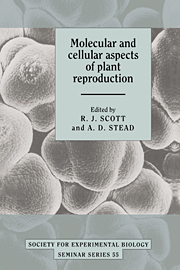Book contents
- Frontmatter
- Contents
- List of Contributors
- Introduction: ‘Where do we go from here?’
- Molecular control of floral organogenesis and plant reproduction in Petunia hybrida
- Control of floral morphogenesis in cauliflower (Brassica oleracea L. var. botrytis): the role of homeotic genes
- Isolation and properties of mutants of Arabidopsis thaliana with reduced sensitivity to short days
- Asexual mutants in Melandrium album (Silene alba): tools in cDNA cloning and analysis of an X/Y chromosome system in plants
- Pollen exine – the sporopollenin enigma and the physics of pattern
- The diversity and regulation of gene expression in the pathway of male gametophyte development
- Characterisation of Arabidopsis thaliana anther-specific gene which shares sequence similarity with β-1,3-glucanases
- Ovule cDNA clones of Petunia hybrida encoding proteins homologous to MAP and shaggy/zeste-white 3 protein kinases
- Towards the elucidation of the mechanisms of pollen tube inhibition during the self-incompatibility response in Papaver rhoeas
- Intracellular movement and pollen physiology: progress and prospects
- Organisation and functions of cell surface molecules on gametes of the brown algae Fucus
- Strategies of flower senescence – a review
- The physiology of petal senescence which is not initiated by ethylene
- Molecular biology of flower senescence in carnation
- Ethylene sensitivity and flower senescence
- Ethylene biosynthetic genes and inter-organ signalling during flower senescence
- Index
The physiology of petal senescence which is not initiated by ethylene
Published online by Cambridge University Press: 04 August 2010
- Frontmatter
- Contents
- List of Contributors
- Introduction: ‘Where do we go from here?’
- Molecular control of floral organogenesis and plant reproduction in Petunia hybrida
- Control of floral morphogenesis in cauliflower (Brassica oleracea L. var. botrytis): the role of homeotic genes
- Isolation and properties of mutants of Arabidopsis thaliana with reduced sensitivity to short days
- Asexual mutants in Melandrium album (Silene alba): tools in cDNA cloning and analysis of an X/Y chromosome system in plants
- Pollen exine – the sporopollenin enigma and the physics of pattern
- The diversity and regulation of gene expression in the pathway of male gametophyte development
- Characterisation of Arabidopsis thaliana anther-specific gene which shares sequence similarity with β-1,3-glucanases
- Ovule cDNA clones of Petunia hybrida encoding proteins homologous to MAP and shaggy/zeste-white 3 protein kinases
- Towards the elucidation of the mechanisms of pollen tube inhibition during the self-incompatibility response in Papaver rhoeas
- Intracellular movement and pollen physiology: progress and prospects
- Organisation and functions of cell surface molecules on gametes of the brown algae Fucus
- Strategies of flower senescence – a review
- The physiology of petal senescence which is not initiated by ethylene
- Molecular biology of flower senescence in carnation
- Ethylene sensitivity and flower senescence
- Ethylene biosynthetic genes and inter-organ signalling during flower senescence
- Index
Summary
Es ist also kein Zweifel, dass schon mit dem Beginn des Aufblühens das Schicksal der Blütenblätter besiegelt ist und die Prozesse eingeschaltet werden, deren Ablauf nach kürzerer oder längerer Zeit das Leben der Blütenblätter begrenzt.
(There is, therefore, no doubt that the fate of the petals has already been sealed by the beginning of flower opening, and that the processes which limit the life of the petals, be it a shorter or longer period, have been initiated.)
W. Schumacher, 1953. Planta 42: 42–55Introduction
Petals have an important function: the attraction of pollinators. Conspicuous petals are, therefore, only found in plants that are pollinated by animals. Attraction of pollinators is terminated by wilting of the petals, by abscission of turgid petals, or by petal colour changes. A change in colour, if it occurs, normally precedes wilting or abscission.
Schumacher (1953), quoted above, expressed what has become a widely accepted hypothesis: the functional life of the petals is genetically determined at an early phase of development, resulting in the expression of genes that are involved in cellular breakdown of the petals in the species that show wilting, in the changes in the abscission zone cells in the species that show abscission, and in the colour changes if these occur. The nature of the physiological processes leading to cellular degradation, and those leading to abscission is only partially known.
- Type
- Chapter
- Information
- Molecular and Cellular Aspects of Plant Reproduction , pp. 239 - 254Publisher: Cambridge University PressPrint publication year: 1994
- 14
- Cited by



